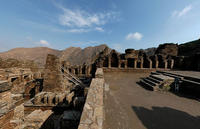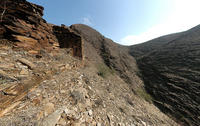You are in: Asia -> Pakistan -> Buddhist Ruins of Ta... , and traditional search or Image Gallery will yield results of this site only
Buddhist Ruins of Takht-i-Bahi and Neighbouring City Remains at Sahr-i-Bahlol
| Site number: | 140 |
|
| Type of site: | Cultural | |
| Date: | 1st century | |
| Date of Inscription: | 1980 | |
| Location: | Asia, Pakistan, North West Frontier Province | |
Up to 75 images are shown here. Click on each for more details or on Image Gallery for more images.
| Description: | Takht-i-Bahi (Throne of Origins), a Buddhist monastic complex, was founded in the early 1st century. As a result of its location atop the crest of a high hill, it escaped successive invasions and still stands exceptionally well preserved. Close to the site stand the ruins of Sahr-i-Bahlol, once a small fortified city that dates from the same period. --WHMNet paraphrase from the description at WHC Site, where additional information is available. For 360 degree imaging of this site, click here. | |
| Takht-i-Bahi (or Takhtbai or Takht Bahai) is a site of historical importance in the Mardan District of the North-West Frontier Province of Pakistan. It contains the remains of a famous Buddhist monastery from the 1st century CE and is listed as a UNESCO World Heritage Site. Takht means "throne" and bahi, "water" or "spring" in Persian/Urdu. The monastic complex was called Takht-i-Bahi because it was built atop a hill and also adjacent to a stream. Takhtbai is the most fertile tehsile in the Mardan Division, There are many crops grown in the Takht Bai Tehsile, some of which are tobacco, wheat and sugar cane. Asia's first sugar mill was built here by the British Government near the Buddhist monastery. The villages of Lund Khwar, Sher Garh Charsadda Sehri-Bahloland is another historical place in the vicinity of Takht-Bhai. It contains the remains of Buddah which has not been properly excavated. The word "Sehri-Bahlol" has been explained by various people in different ways. The local people, however, explain that this a word of Hindi Language and means "Sir Bahlol" a prominent political and religiously leader of the area. However the name is not so old as the village Sehri-Bahlol. The village is located on hillack surrounded by lush green field where the local people practice agriculture. Economically people are poor whith low literacy ratio. The local people continue illegal excavation in their homes and land demaging the historical monoments. Some of the local dealors of antiques misguide the local population and instigate them to involve them in illegal excavation. It requires national and international attention so that to reserve the raimnants at Sehri-Bahlol. --Wikipedia. Text is available under the Creative Commons Attribution-ShareAlike License. For 360 degree imaging of this site, click here. | ||
| Source: | http://whc.unesco.org/en/list/140 | |
| Reference: | 1. UNESCO World Heritage Center, Site Page. | |
















